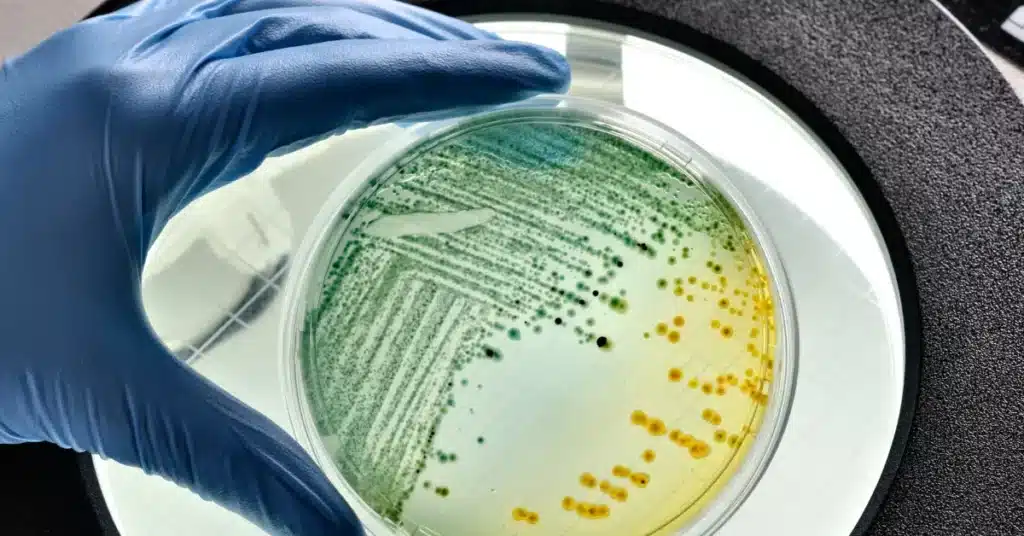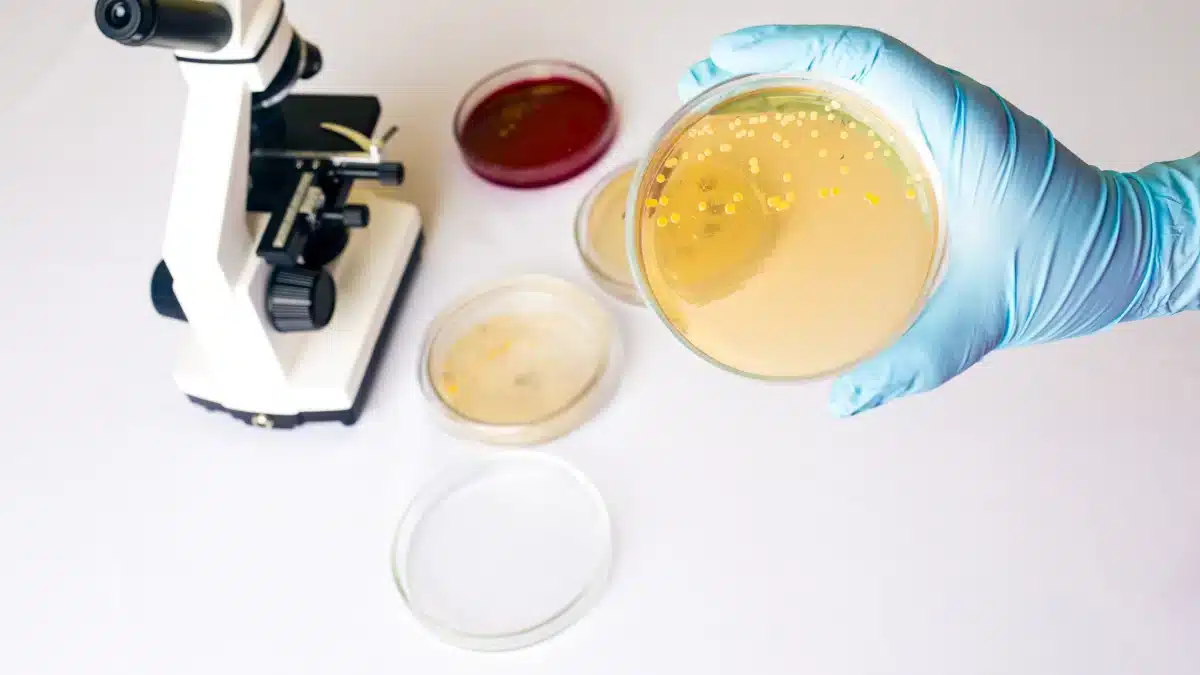Identifying the Culprit: What Bacteria Causes UTI?
Urinary Tract Infections (UTIs) are a common health concern, particularly among women, primarily triggered by bacterial intrusion into the urinary tract.
UTIs can bring discomfort and disruption to daily life, emphasizing the importance of understanding the bacteria behind these infections.
Recognizing the types of bacteria that causes UTI is pivotal for effective treatment and prevention.
Continue reading the article to learn more about “What bacteria causes UTI?”.
Understanding UTI Bacteria
Bacterias are the main reason that can cause a UTI.
Some of the bacteria that cause UTI include:
Escherichia coli

Escherichia coli, also commonly known as E. coli, is the primary bacteria causing UTIs.
This bacterium is responsible for over 90% of uncomplicated UTIs.
E. coli’s prevalence is particularly pronounced among females, primarily due to anatomical factors.
Its harmful characteristics, combined with the fact that the female urethra is close to the rectum, emphasize its importance in causing UTIs.
Klebsiella pneumoniae
Klebsiella pneumoniae is another bacterium that can cause severe UTIs and may escalate into kidney infections.
Its resistance to antibiotics poses treatment difficulties, introducing complexities in managing the condition.
The bacterium’s ability to form biofilms using type 1 pili further complicates its involvement in UTIs.
Proteus mirabilis
Proteus mirabilis is distinguished by its tendency to swarm, effectively moving through the urinary tract.
Additionally, it can contribute to the formation of stone-like structures within the urinary system, increasing recurrent infections.
As a UTI-causing agent, it can also engage in co-infections with other pathogens.
Enterococci
Enterococci, including Enterococcus faecalis and Enterococcus faecium, occasionally contribute to UTIs.
Encountered primarily in healthcare settings, these bacteria form biofilms and display inherent antibiotic resistance.
This complexity complicates both diagnosis and treatment.
Staphylococcus saprophyticus
Staphylococcus saprophyticus primarily targets sexually active young women.
By attaching to the urinary tract lining, it initiates infections.
Antibiotic-resistant strains add to the complexities of managing diseases caused by this bacterium.
Pseudomonas aeruginosa
Pseudomonas aeruginosa is particularly relevant in complicated UTIs, often seen in healthcare environments.
Its ability to resist antibiotics and adapt easily allows it to endure within the urinary tract.
Staphylococcus aureus
Staphylococcus aureus, often associated with skin and wound infections, can also play a role in UTIs.
Its ability to establish itself and its strong infection-causing characteristics emphasize its potential influence.
Mechanisms of infection
These bacteria enter the urinary tract via the urethra, establishing a starting point for infection.
Once settled within, they activate the body’s immune response, which sets off a chain of events.
This gives rise to common UTI symptoms such as increased urination frequency, discomfort, and pain.
This interaction between bacteria and the body’s defenses leads to the development of UTIs.
Preventing Urinary Tract Infections
Preventing Urinary Tract Infections (UTIs) involves adopting specific practices and habits that can substantially lower the risk of bacterial infections.
Here are some effective preventive measures:
Stay adequately hydrated

Ensuring regular intake of fluids, particularly water, is essential to help flush bacteria out of the urinary tract and bladder.
Maintaining hydration encourages frequent urination, which aids in expelling bacteria from the urinary tract.
Urinate before and after intimacy
Emptying the bladder both before and after sexual activity helps in clearing any potential bacteria that may have entered the urethra during intercourse.
This practice effectively prevents the migration of bacteria to the bladder, curbing the risk of infection.
Adopt the proper wiping technique
The front-to-back wiping technique, particularly after bowel movements, is crucial when using the restroom to decrease the risk of UTIs.
This hygienic approach prevents the transfer of anal bacteria to the urethra and vaginal area, significantly reducing the UTI risk.
Opt for showers over baths
Opting for showers instead of baths can contribute to lowering the likelihood of UTIs.
Baths possess the potential to introduce bacteria into the urethra, making showers the more sanitary option.
Minimize genital area products
Avoid using douches, sprays, or powders in the genital region, as they can disturb the innate bacterial equilibrium, consequently increasing the susceptibility to UTIs.
Consider incorporating cranberry products

Cranberry juice or supplements could offer some degree of preventive benefits against UTIs.
Active compounds within cranberries may deter bacteria from adhering to urinary tract walls.
Takeaway
Urinary Tract Infections (UTIs) can occur from diverse bacteria invading the urinary tract.
Among the culprits, Escherichia coli (E. coli) takes precedence, followed by Klebsiella pneumoniae, Proteus mirabilis, and others.
These bacteria’s entry prompts infections, resulting in discomfort and potential complications.
Preventing UTIs involves maintaining hydration, practicing pre and post-intimacy urination, proper hygiene, minimizing genital products, and contemplating cranberry-based interventions.
While these strategies effectively reduce UTI risks, it is essential to remain mindful of these bacteria and seek professional guidance for informed prevention.
Consult your doctor and order Levoflox 750mg from WowRx at an affordable price.
Frequently Asked Questions
What are the primary bacteria responsible for causing UTIs?
The most common bacteria associated with Urinary Tract Infections (UTIs) is Escherichia coli (E. coli). Other contributors include Klebsiella pneumoniae, Proteus mirabilis, Enterococci, Staphylococcus saprophyticus, Pseudomonas aeruginosa, and Staphylococcus aureus.
Why is E. coli a significant bacteria in UTIs?
E. coli is a significant bacteria in UTIs because it’s commonly found in the urinary tract and accountable for 90% of uncomplicated UTIs. Understanding its prevalence aids in addressing and preventing these infections effectively.
What happens once bacteria enter the urinary tract?
Bacteria gain entry through the urethra, establishing a starting point for infection. They then activate the body’s immune response, leading to UTI symptoms such as frequent urination, discomfort, and pain.
What types of bacteria cause UTI?
Urinary Tract Infections (UTIs) are primarily caused by bacteria such as Escherichia coli (E. coli), Klebsiella pneumoniae, and Proteus mirabilis. These bacteria can enter the urinary tract, leading to discomfort and symptoms like frequent urination and pain.
What are the top 3 bacteria in UTI?
The top three bacteria commonly causing UTIs are Escherichia coli (E. coli), Klebsiella pneumoniae, and Proteus mirabilis. These bacteria can enter the urinary tract, leading to infections and resulting symptoms like pain and frequent urination.
WowRx uses only high-quality sources while writing our articles. Please read our content information policy to know more about how we keep our content reliable and trustworthy.






